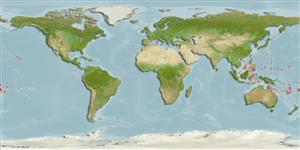>
Ovalentaria/misc (Various families in series Ovalentaria) >
Pomacentridae (Damselfishes) > Pomacentrinae
Etymology: Pomacentrus: Greek, poma, -atos = cover, operculum + Greek, kentron = sting (Ref. 45335); spilotoceps: Name from the Greek 'spilotos' for spotted and 'ceps' as short for head, referring to the orange or yellow spots on the head, its most characteristic markings..
More on author: Randall.
Environment: milieu / climate zone / depth range / distribution range
Ecologie
marien rifbewoner; diepte 0 - 5 m (Ref. 86942). Tropical
Verspreiding
Landen | FAO regio's | Ecosystemen | Voorkomen | Point map | Introducties | Faunafri
South Pacific: Fiji and Tonga.
Grootte / Gewicht / Leeftijd
Maturity: Lm ? range ? - ? cm
Max length : 7.8 cm SL mannelijk / geslacht onbekend; (Ref. 54980)
Dorsale stekels (totaal): 8; Dorsale zachte stralen (totaal): 14-15; Anale stekels 2; Anale zachte stralen: 15; Wervels: 26. This species is distinguished by the following characters: D XIII,14-15 (usually 15); A II,15; pectoral rays 18; tubed lateral line scales 17-18 (usually 18); total gill rakers 22-24; sub-orbital naked and the margin serrate; posterior edge of pre-orbital with a strong retrorse spine; body depth 1.95-2.1 in SL; longest dorsal spine 1.55-1.65 in HL; second anal spine 1.4-1.5 in HL. Colouration: yellowish brown, scale edges blackish; dull yellow to pale orange spots on opercle and anterior to and above pectoral fin base; two blue lines on side of snout crossing the upper lip; a small vertically elongate deep blue or black spot at the upper end of gill opening, a small black spot at upper pectoral fin base; in adults the ocellus posteriorly in lower half of dorsal fin may be present or absent; caudal fin abruptly yellowish (Ref. 124650).
Occurs on shallow coral reegs in calm areas (Ref. 124650). Diurnal species (Ref. 52881). Oviparous, distinct pairing during breeding (Ref. 205). Eggs are demersal and adhere to the substrate (Ref. 205). Males guard and aerate the eggs (Ref. 205).
Levenscyclus en paargedrag
Maturiteit | Voortplanting | Paaien | Eieren | Fecunditeit | Larven
Oviparous, distinct pairing during breeding (Ref. 205). Eggs are demersal and adhere to the substrate (Ref. 205). Males guard and aerate the eggs (Ref. 205).
Randall, J.E., 2002. Two new damselfishes of the genus Pomacentrus from the south-west Pacific. aqua, J. Ichthyol. and Aquat. Biol. 5(4):167-176. (Ref. 124650)
Status op de Rode Lijst van het IUCN (Ref. 130435)
Gevaar voor de mens
Harmless
Gebruik door de mens
Meer informatie
Leeftijd/GrootteGroeiLengte-gewichtLengte-lengteLengtefrequentiesMorfometrieMorfologieLarvenLarvale populatiedynamiekRekruteringAbundantieBRUVS
ReferentiesAquacultuurAquacultuurprofielKweeklijnenGeneticaElectrophoresesErfelijkheidZiektesVerwerkingNutrientsMassaconversie
Tools
Speciale rapporten
Download XML
Internetbronnen
Estimates based on models
Preferred temperature (Ref.
123201): 25.1 - 29.4, mean 28.4 °C (based on 1179 cells).
Fylogenetische diversiteitsindex (Ref.
82804): PD
50 = 0.5000 [Uniqueness, from 0.5 = low to 2.0 = high].
Bayesian length-weight: a=0.02399 (0.01139 - 0.05051), b=2.98 (2.81 - 3.15), in cm total length, based on LWR estimates for this Genus-body shape (Ref.
93245).
Trofisch niveau (Ref.
69278): 2.7 ±0.3 se; based on size and trophs of closest relatives
Weerstandsvermogen (Ref.
120179): Hoog, minimale populatieverdubbelingstijd minder dan 15 maanden (Preliminary K or Fecundity.).
Fishing Vulnerability (Ref.
59153): Low vulnerability (10 of 100).
Nutrients (Ref.
124155): Calcium = 428 [151, 957] mg/100g; Iron = 1.08 [0.54, 2.44] mg/100g; Protein = 17.4 [15.8, 18.8] %; Omega3 = 0.127 [0.050, 0.296] g/100g; Selenium = 9.29 [3.14, 25.41] μg/100g; VitaminA = 480 [88, 2,512] μg/100g; Zinc = 4.35 [2.39, 7.67] mg/100g (wet weight);
